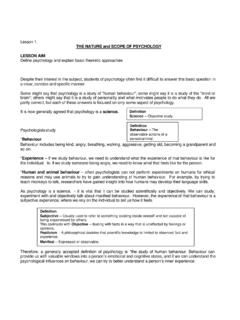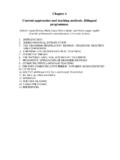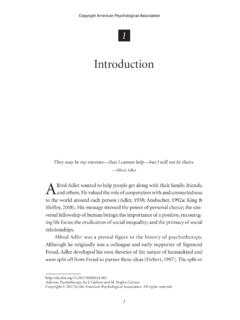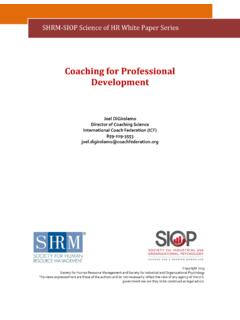Transcription of AQA Psychology for A Level Year 2 Revision Guide 2nd ...
1 Illuminate Publishing AQA Psychology for A Level Year 2 Revision Guide 2nd Edition Knowledge Check answers AQA Psychology for A Level Year 2 Revision Guide 2nd Edition Knowledge Check answers PLEASE NOTE: This document contains suggested model answers that would achieve a good mark if provided in an exam. They are designed to help Guide and instruct you but should not be considered definitive or the only answers you could give. Chapter 1 approaches in Psychology Page 11. 1. The first systematic experimental attempt to study the mind by breaking up conscious awareness into basic structures of thoughts, images and sensations. Isolating the structure of consciousness in this way is called structuralism. 2. In 1879, Wundt opened the first experimental Psychology lab with the aim of describing the nature of human consciousness (the mind'). He pioneered the method of introspection the first attempt to study the mind by breaking up conscious awareness into basic structures of thoughts, images and sensations.
2 Isolating the structure of consciousness in this way is called structuralism. The same standardised instructions were given to all participants so procedures could be repeated (replicated). For instance, participants were given a ticking metronome and they would report their thoughts, images and sensations, which were then recorded. Wundt recorded the introspections within a controlled lab environment and all participants were tested in the same way. For this reason, Wundt's research can be considered a forerunner to the later scientific approaches in Psychology that were to come. Other aspects of this research would be considered unscientific, however. Wundt relied on participants self-reporting their private' mental processes. Such data is subjective and participants may not have wanted to reveal some of the thoughts they were having. Participants would also not have had exactly the same thoughts every time, so establishing general principles would not have been possible (one of the key aims of science).
3 3. Watson (1913) argued that introspection was subjective, in that it varied from person to person. According to the behaviourist approach, scientific' Psychology should only study phenomena that can be observed and measured. Skinner (1953) brought the language and rigour of the natural sciences into Psychology . The behaviourists' focus on learning, and the use of carefully controlled lab studies, would dominate Psychology for the next few decades. Many claim that a scientific approach to the study of human thought and experience is not possible, nor is it desirable, as there are important differences between the subject matter of Psychology and the natural sciences. Also, there are approaches in Psychology that employ methods that are much less rigorous and controlled than the behaviourist approach such as the humanistic and psychodynamic approaches which rely on more subjective methods such as case studies. Page 13. 1. Classical conditioning is a form of learning in which a neutral stimulus ( bell) can come to elicit a new learned response (conditioned response, CR) through association.
4 1. PLEASE NOTE: This document contains suggested model answers that would achieve a good mark if you gave them in an exam. They are designed to help Guide and instruct you, but they should not be considered definitive or the only answers you could give. Illuminate Publishing AQA Psychology for A Level Year 2 Revision Guide 2nd Edition Knowledge Check answers 2. Rats and pigeons were placed in specially designed cages (Skinner boxes). When a rat activated a lever (or a pigeon pecked a disc) it was rewarded with a food pellet. A desirable consequence led to behaviour being repeated. If pressing a lever meant an animal avoided an electric shock, the behaviour would also be repeated. 3. Positive reinforcement receiving a reward when behaviour is performed makes it more likely to be repeated. Thus a child could be encouraged to come at 9pm by being allowed to stay out until 10pm at the weekend if they do. Negative reinforcement when an animal or human produces behaviour that avoids something unpleasant.
5 Before the child leaves the house they could be warned that if they are not in by 9pm, they will be grounded for the rest of the week. 4. The behaviourist approach is only concerned with studying behaviour that can be observed and measured. It is not concerned with mental processes of the mind. Introspection was rejected by behaviourists as its concepts were vague and difficult to measure. Behaviourists tried to maintain more control and objectivity within their research and relied on lab studies to achieve this. They also suggest that the processes that govern learning are the same in all species, so animals ( rats, cats, dogs and pigeons) can replace humans as experimental subjects. Pavlov introduced the concept of classical conditioning by training dogs to salivate at the sound of a bell. Pavlov showed how a neutral stimulus (bell) can come to elicit a new learned response (conditioned response) through association by presenting the bell and food together on several occasions. Skinner placed rats and pigeons in specially designed cages (Skinner boxes).
6 When a rat activated a lever (or a pigeon pecked a disc) it was rewarded with a food pellet. A desirable consequence led to behaviour being repeated. If pressing a lever meant an animal avoided an electric shock, the behaviour would also be repeated. This is operant conditioning behaviour is shaped and maintained by its consequences. One strength of behaviourism is that it uses well-controlled research. The approach has focused on the careful measurement of observable behaviour within controlled lab settings. Behaviourists have broken behaviour down into stimulus response units and studied causal relationships. This suggests that behaviourist experiments have scientific credibility. However, this approach may oversimplify learning and ignore important influences on behaviour ( thought). Other approaches ( social learning and cognitive) incorporate mental processes. This suggests learning is more complex than just what we can observe. Another strength is behaviourist laws of learning have real-world application.
7 The principles of conditioning have been applied to a broad range of real-world behaviours and problems. Token economy systems reward appropriate behaviour with tokens that are exchanged for privileges (operant conditioning). These are successfully used in prisons and psychiatric wards. This increases the value of the behaviourist approach because it has widespread application. One limitation is behaviourism is a form of environmental determinism. The approach sees all behaviour as determined by past experiences that have been conditioned and ignores any influence that free will may have on behaviour. Skinner suggested that free will was an illusion. When something happens we may think, I made the decision to do that' but our past conditioning 2. PLEASE NOTE: This document contains suggested model answers that would achieve a good mark if you gave them in an exam. They are designed to help Guide and instruct you, but they should not be considered definitive or the only answers you could give.
8 Illuminate Publishing AQA Psychology for A Level Year 2 Revision Guide 2nd Edition Knowledge Check answers determined the outcome. This is an extreme position and ignores the influence of conscious decision-making processes on behaviour (as suggested by the cognitive approach). Page 15. 1. Children are more likely to imitate the behaviour of people with whom they identify. Such role models are similar to the observer, tend to be attractive and have high status. For instance, a little boy may identify with Justin Bieber because of his popularity, attractiveness and boundless talent. 2. In a controlled observation, children watched either: an adult behaving aggressively towards a Bobo doll; or an adult behaving non-aggressively towards a Bobo doll. When given their own doll to play with, the children who had seen aggression were much more aggressive towards the doll. This suggests that children may learn aggressive behaviour through observation and imitation of adult role models. 3.
9 To learn to bake a cake a child must first pay attention to the actions of its mother. The child must store the sequence of events in memory (retention) the ingredients, lining the cake tin, etc. The child must be capable of reproducing the behaviour they must have access to the correct utensils and be physically capable of imitating the actions. Finally, the child must be motivated to reproduce the behaviour. They may have observed cake-making behaviour being rewarded in the past such as the look on their mum's happy face when tucking into what she has made (vicarious reinforcement). 4. Bandura agreed with the behaviourist approach that learning occurs through experience. However, he also proposed that learning takes place in a social context through observation and imitation of others' behaviour. Children (and adults) observe other people's behaviour and take note of its consequences. Behaviour that is seen to be rewarded (reinforced) is much more likely to be copied than behaviour that is punished.
10 Bandura called this vicarious reinforcement. Mediational (cognitive) processes play a crucial role in learning. There are four mediational processes in learning: 1. Attention whether behaviour is noticed. 2. Retention whether behaviour is remembered. 3. Motor reproduction being able to do it. 4. Motivation the will to perform the behaviour. The first two processes relate to the learning of behaviour, the last two relate to the performance of behaviour (so, unlike behaviourism, learning and performance do not have to occur together). Finally, identification with role models is also important. Children are more likely to imitate the behaviour of people with whom they identify. Such role models are similar to the observer, tend to be attractive and have high status. One strength is SLT emphasises the importance of cognitive factors. Neither classical conditioning nor operant conditioning can offer a comprehensive account of human learning on their own because cognitive factors are omitted.







